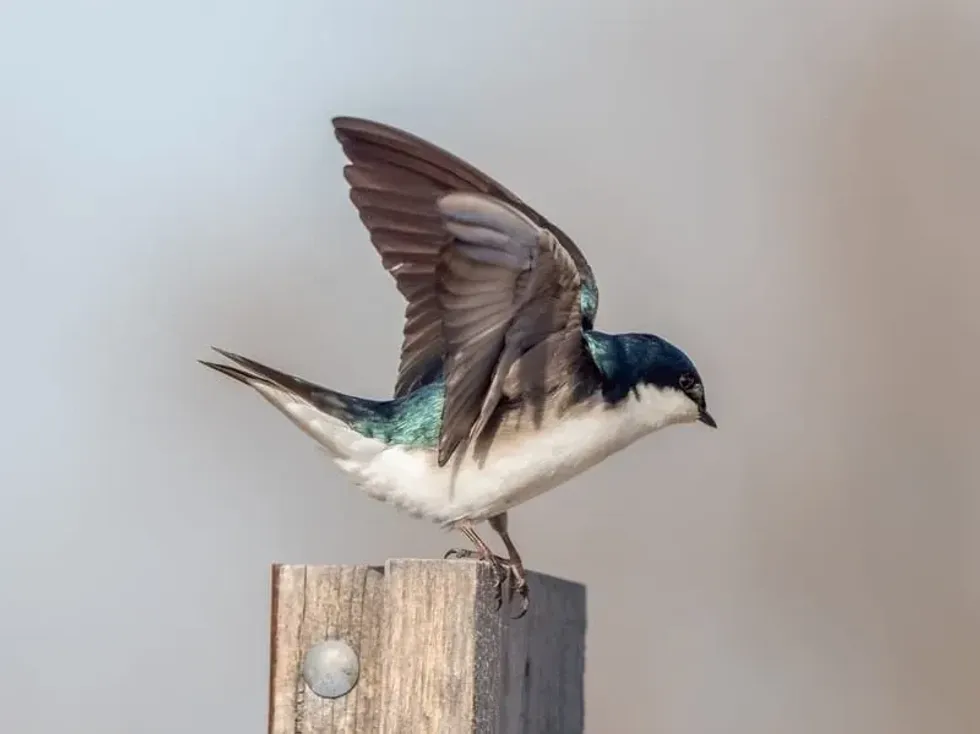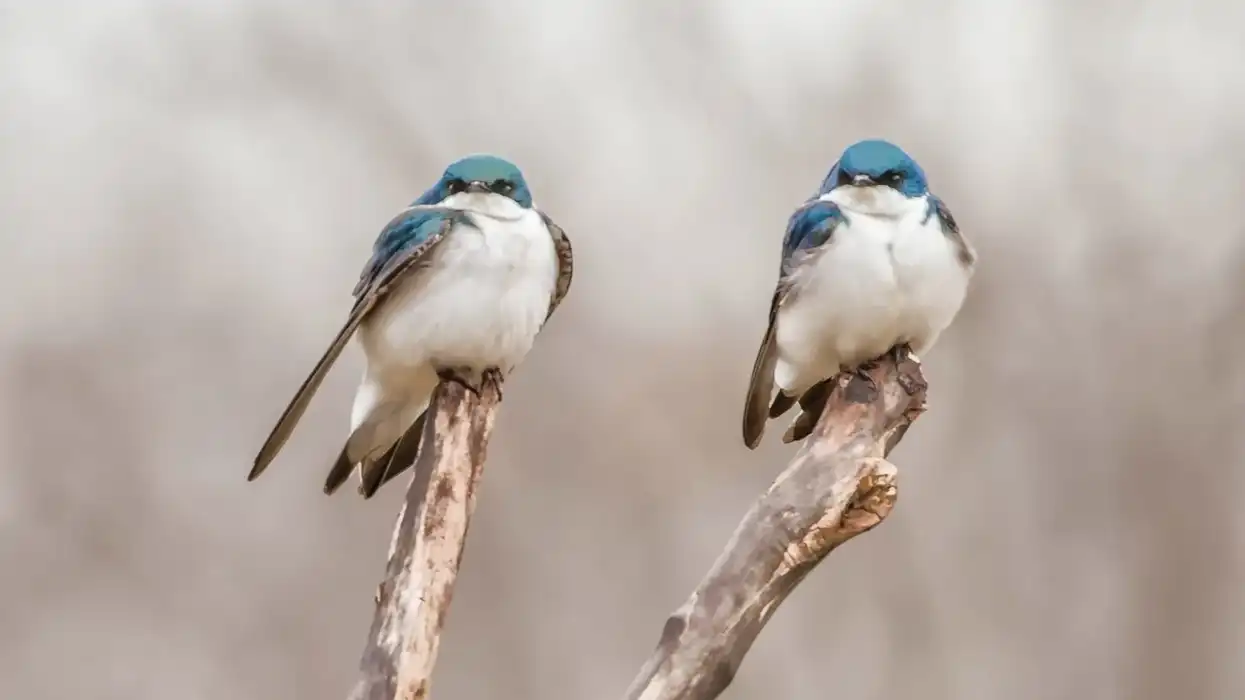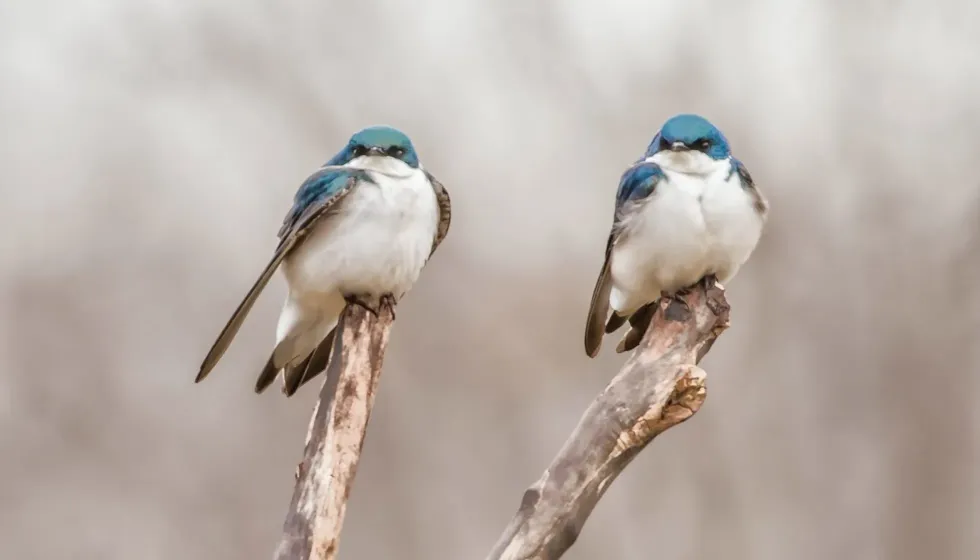Fun Tree Swallow Facts For Kids

Tree swallows are migratory birds and nest in isolated pairs or loose groups. They are known as aerial insectivores as they feed on insects while being airborne.
Tree swallows can be found in North America during spring, summer, and fall. Their nest sites are found in fields or marshes near water bodies. Tree swallows have their own song, which can be heard clearly during the summer months.
It is a sweet chirping call. During the winters, they migrate to the south.
Tree swallows sing in three parts – the whine, the chirp, and the gurgle. The first one is a chirping call made by females during copulation – or by both males and females while interacting with the nestlings – and by the males when they leave or enter the nests.
The whine is an anxiety call and can be made to announce danger or predators. The gurgle comes at the end of the song, and it is said twice. It is an indication of pair bonding.
Read on for all the fascinating tree swallow facts. After reading these interesting articles on the tree swallow bird species, do check our other articles on the violet-green swallow and the Australian magpie as well.
Tree Swallow Interesting Facts
What type of animal is a tree swallow?
A tree swallow is a kind of bird that is found mostly in North America and the Caribbean. Tree swallows are migratory birds known for their songs and brilliant colors.
What class of animal does a tree swallow belong to?
The tree swallow belongs to the Aves class of animals. It lays eggs like most birds in its nest sites which are present in open areas near water.
How many tree swallows are there in the world?
According to some calculations, there are about 19 million individual tree swallows in their natural habitats. Tree swallows are not an endangered species right now, but the population could be declining due to loss of habitat and human encroachment, especially the spots where they are wintering.
Where does a tree swallow live?
Tree swallows are found in Central and North America. They will travel northernmost only until there are trees and water.
They are migratory birds and winter, mostly in the southern regions of North America, which includes Florida, the Caribbean coast of Central America, and the Gulf Coast towards Panama. Tree swallows nest in tree cavities in their habitat region.
In and around cities, they are more than ready to accept nest boxes as their preferred habitat. Tree swallow nest is prepared from mud which is lined with feathers to provide insulation.
This nest is quite different from the traditional nest prepared by a sparrow which is prepared from bark strips, twigs, and weeds that is insulated with hair and feathers. But if given a chance, a sparrow will readily take over the nest of a tree swallow.
What is a tree swallow's habitat?
The tree swallow habitat is in open areas, near a water body. They are found in marshes, fields, shorelines, meadows, wooded swamps, and beaver ponds.
They build their nests in hollow trees or any such cavity. Mostly found in holes excavated by sapsuckers or standing dead trees, in artificial nest boxes, or under a building. In their natural habitat, tree swallow nests can be usually found in abandoned woodpecker holes in dead trees.
In urban areas, they take well to nest boxes. If you wish to install a nest box for tree swallow, make sure that it faces the northeast direction and is placed around 5 ft (1.66 m) from the ground.
Who do tree swallows live with?
They live in pairs or loose groups. The tree swallow is a social bird and may form a flock of thousands of birds for a nighttime roost. Swallows are highly territorial especially around the time when they breed.
How long does a tree swallow live?
The tree swallow lives for up to 11 years. The average life span is around 10 years. The survival rate for an adult tree swallow is 40-60% on average. The oldest one found was around 11 years old.
How do they reproduce?
Tree swallows are monogamous birds. Breeding pairs are formed once the females arrive in spring at the breeding sites.
They may also do extra-pair copulation as many nests may contain babies which are not fathered by the resident males. The breeding season of a swallow is between May and September, and one brood a year is raised by each pair.
The pair will nest solitary, but it is observed that they build nests close to other pairs. The females will start with the nest building in late April or early May.
The nest is lined with grasses and feathers from other birds. The females will take a few days to two weeks to build a nest. Then she will lay two to eight tree swallow eggs, one each day, and incubate them for 11-19 days in the tree swallow nest or tree swallow house.
For the first three days, the female will take care of the altricial nestlings. Both parents will feed and forage for food for their babies.
They fledge 15-25 days later and are ready to fly. The parents will continue to feed the kids after they have left the nests for three days.
The chicks can breed next season if they find a suitable nesting spot. At first, during courtship, the male may attack a female, and the female may respond back with a wing fluttering fight which is considered to be an invitation to court.
What is their conservation status?
Tree swallows have a stable population, with around 20 million individuals in the world, which justifies the fact that it is classified as of Least Concern by the International Union for Conservation of Nature.
Tree Swallow Fun Facts
What do tree swallows look like?

Tree swallows are recognized by their brilliant blue color on their back, which is iridescent deep blue and white below. They have blackish wings and tails. The tree swallow is known for its acrobatic twists and turns while catching its prey.
The bright blue color of their wings looks mesmerizing in the sun. The underwing coverts are gray-brown, with a black bill, dark brown eyes, and pale brown feet and legs. The females are duller in color, and some also retain their juvenile plumage until the age of three.
How cute are they?
They are cute, colorful, and iridescent. They are medium to small birds who are known for their song.
How do they communicate?
The tree swallow song and tree swallow calls are sung in three parts: the whine, the chirp, and the gurgle. The first one is a chirping call made by females during copulation – or by both males and females while interacting with the nestlings – and by the males when they leave or enter the nests.
The whine is an anxiety call and can be made to announce danger or predators. It is an indication of pair bonding. Tree swallow singing is generally regarded as melodious.
The males will give out a chatter call to let the females know about their nesting site or to intrude conspecifics. Sometimes they give out a short high-pitched submission call after an aggressive meeting with another tree swallow. They communicate with their nestlings, too, via some calls and specific noises.
How big is a tree swallow?
The tree swallow is around 4.7-5.5 in (11.9-13.9 cm) long. They are small birds with wide and long wings, and small feet and legs. Tree swallow nesting box must be made accordingly as their wingspan can extend up to 11.8-13.8 in (29.9-35 cm).
How fast can a tree swallow fly?
The tree swallow can have a flying speed of 45 mph (72 kph). The tree swallow flying is a good sight to behold.
How much does a tree swallow weigh?
The tree swallow weighs 0.59-0.89 oz (0.01-0.02 kg). It is a small bird with an impressive wingspan.
What are the male and female names of the species?
The male and female tree swallows do not have a specific name, they are known as male tree swallows and female tree swallows, respectively. Their group or flock is called a stand.
What would you call a baby tree swallow?
Baby tree swallows are called chicks or nestlings or juvenile tree swallow birds. Tree swallow chicks are quite an adorable sight to behold.
What do they eat?
Tree swallows are insectivorous and tree swallows eat flying insects. The tree swallow diet may consist of some plants but not very often. These North American birds forage for food in flights while hovering above water or ground.
They may forage in flocks if the number of insects is high. They can glean insects from a water surface or a vertical ledge.
They will feed from dawn until dusk on flies, beetles, and ants. Sometimes they feed on mayflies, stoneflies, spiders, mosquitoes, caddisflies, and grasshoppers. Unlike other similar species, tree swallows eat bayberries, bulrushes, and other seeds if the weather conditions are not suitable.
The known predators for a tree swallow are black rat snakes, American kestrels, chipmunks, American crows, and raccoons.
Are they dangerous?
Swallows are not dangerous to humans in any way. Tree swallows are losing their natural habitat due to human encroachment. They get very aggressive when it comes to securing their nesting site from encroachers as suitable nest sites are quite scarce in their natural habitat.
Would they make a good pet?
If you like listening to the sounds of the birds and enjoy their singing, it is a good pet for you. They are small birds who may survive in an enclosed space that is big enough for a pair.
Did you know...
The tree swallows love to bathe. They will skim their bodies against the surface and then rise quickly to shake off the water.
Tree swallow migration takes place in the midst of the year.
The tree swallow's nests
They build their nests in hollow trees or any such cavity. Mostly found in sapsucker-excavated holes or standing dead trees, in artificial nest boxes, or under the eaves of a building.
They may also build hollow nest stumps over water, fire hydrants, steel drums, holes in-ground, or holes dug by other birds like a woodpecker. The nest is made of mosses, grasses, aquatic plants, and rootlets and lined with feathers from other birds.
The females will take a few days to two weeks to build a nest. The nesting spot is decided by the males and shown off to the female before copulation happens.
How does the tree swallow compare to other swallows?
Tree swallows usually stay in cavities that are usually made by woodpeckers or tree boxes. They also have an iridescent back and a white underside. On the other hand, a barn swallow stays in mud nests, in open fields. They also have a dark blue back and a deep red throat and forehead.
When you compare barn swallow vs tree swallow, it is evident that the barn swallow is larger in size as compared to a tree swallow. Moreover, barn swallows use mud to prepare the nests that are placed along a supporting structure, while tree swallows used woodpecker holes in dead trees for their nests.
In terms of similarities in appearance, the northern rough winged swallow exhibits a remarkable similarity to the tree swallow.
Here at Kidadl, we have carefully created lots of interesting family-friendly animal facts for everyone to discover! Learn more about some other birds from our mockingbird fun facts and gray catbird facts pages.
You can even occupy yourself at home by coloring in one of our free printable tree swallow coloring pages.
We Want Your Photos!
More for You
See All
Bachelor of Arts specializing in English Literature

Akinwalere OlaleyeBachelor of Arts specializing in English Literature
As a highly motivated, detail-oriented, and energetic individual, Olaleye's expertise lies in administrative and management operations. With extensive knowledge as an Editor and Communications Analyst, Olaleye excels in editing, writing, and media relations. Her commitment to upholding professional ethics and driving organizational growth sets her apart. She has a bachelor's degree in English Literature from the University of Benin, Edo State.
Bachelor of Commerce specializing in Marketing and HR

Pradhanya RaoBachelor of Commerce specializing in Marketing and HR
With a Bachelor’s degree in Commerce from Christ University, Bangalore, Pradhanya's passion for the English language and literature led her to explore the field of content writing, where she has gained extensive experience in writing, reviewing, editing, and fact-checking. She has also earned certifications in Google Ads Search, Google Ads Display, and Social Media Marketing, showcasing her proficiency in digital marketing.
Disclaimer
1) Kidadl is independent and to make our service free to you the reader we are supported by advertising. We hope you love our recommendations for products and services! What we suggest is selected independently by the Kidadl team. If you purchase using the Buy Now button we may earn a small commission. This does not influence our choices. Prices are correct and items are available at the time the article was published but we cannot guarantee that on the time of reading. Please note that Kidadl is a participant in the Amazon Services LLC Associates Program, an affiliate advertising program designed to provide a means for sites to earn advertising fees by advertising and linking to Amazon. We also link to other websites, but are not responsible for their content.
2) At Kidadl, we strive to recommend the very best activities and events. We will always aim to give you accurate information at the date of publication - however, information does change, so it’s important you do your own research, double-check and make the decision that is right for your family. We recognise that not all activities and ideas are appropriate for all children and families or in all circumstances. Our recommended activities are based on age but these are a guide. We recommend that these ideas are used as inspiration, that ideas are undertaken with appropriate adult supervision, and that each adult uses their own discretion and knowledge of their children to consider the safety and suitability. Kidadl cannot accept liability for the execution of these ideas, and parental supervision is advised at all times, as safety is paramount. Anyone using the information provided by Kidadl does so at their own risk and we can not accept liability if things go wrong.
3) Because we are an educational resource, we have quotes and facts about a range of historical and modern figures. We do not endorse the actions of or rhetoric of all the people included in these collections, but we think they are important for growing minds to learn about under the guidance of parents or guardians.







